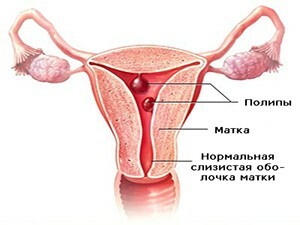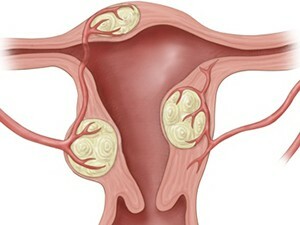Postmenopause is the final phase in the development of the woman's reproductive system. This is a complete cessation not only of menstruation, but also the possibility of pregnancy, childbirth. Although in this period, some people have a problem that causes anxiety or long-term treatment. Occurring spotting after climacteric causes are almost always pathological.
Why in the postmenopausal blood of excreta should not be
 Blood in the mucus from the female reproductive tract in reproductive ageit has a natural origin during menstruation. Separation of the functional layer of the endometrium occurs with damage to its vessels, from which it flows.
Blood in the mucus from the female reproductive tract in reproductive ageit has a natural origin during menstruation. Separation of the functional layer of the endometrium occurs with damage to its vessels, from which it flows.
A year later and longer after the final menstruation, this organ becomes atrophy, it becomes less. The division into the main and functional layer in it no longer exists. Endometrium is made thin, flat.
There are no other factors influencing its cyclic development - sex hormones. Actually, this is the main sign and the culprit of menopause. Therefore, the secreting abilities of internal reproductive organs are, in principle, reduced. This means that discharge in postmenopause if there are, then in very small quantities. There is a sign of dryness of the mucosal perineum and vagina, which causes inconvenience, but is the norm.
However, with discomfort you can and should fight, there are appropriate means for moisturizing and restoring. But for all these reasons, discharge with blood, the more abundant should not be. Yes, and smearing, and those in which the mucus is greater than the red blood cells, should be subjected to study.
Where is the allocation of
? It is impossible to determine the source of excretaions only on stains on clothes or "dessert".It can be excreted from the rectum, the urethra, and not from the vagina. This is also likely, since a decrease in hormonal activity provokes not only gynecological problems.

It is worth knowing that the cervix in the climax still produces mucus, although in a smaller volume. And yellow discharge in women during the postmenopause or clear, white, without an unpleasant odor and not causing discomfort is still the norm.
Undesirable causes of blood discharge in menopause
In most discharges with blood impurities - a signal about something abnormal in the body. There are many options why they appear.
Admission of hormones
The result of the fact that the remedy is chosen incorrectly, can be supersaturation of the body with estrogens. This stimulates to excessive strengthening of the function of the ovaries and the growth of the endometrium, which is manifested by bleeding or malignancies. Brown discharge in postmenopause can mean that the mucus has had time to oxidize, since the cervical canal in the uterus has already decreased in size in this period, and they do not go out quickly.
In such circumstances it is necessary to go to a doctor to help correct the hormonal background. A drug for HRT will have to pick up another one.
Injury to the mucosa
 Sometimes the source of secretions can be found easily and without a tampon, for example, if it slightly covers the wash, the postmenopausal period is sometimes marked by a similar phenomenon. It indicates a mechanical damage to the mucosa in the intimate area. With the attenuation of the production of sex hormones, it becomes thinner and weaker.
Sometimes the source of secretions can be found easily and without a tampon, for example, if it slightly covers the wash, the postmenopausal period is sometimes marked by a similar phenomenon. It indicates a mechanical damage to the mucosa in the intimate area. With the attenuation of the production of sex hormones, it becomes thinner and weaker.
The secretory function of the reproductive organs is also reduced, so it is very easy to get injured while performing hygiene procedures. After all, despite the atrophic processes, the vessels in the shell are present. Only their walls are made fragile, they can collapse with thorough washing, touching with a towel.
Contact excretion during the postmenopause is possible after sex or gynecological examination. The reason for this is still the same thinning of the intimate mucosa. And although the reason for their occurrence is natural, it must be eliminated, since it can lead to malaise.

In this period, erosion is more likely to be traumatic or as a result of trophic disorder due to prolapse of genital organs. Bloody discharge after menopause with sex or sudden movement of the cause may have exactly this nature. Their danger is that traumatic erosion can very quickly turn into a malignant tumor.
Infectious diseases, inflammation
The occurrence of infections in postmenopause does not depend on whether the woman has an intimate life or not. Because hormonal changes provoke not only the atrophy of the mucous membranes, but also the violation of the microflora of the vagina. Now pathogenic bacteria get more freedom to spread, as local immunity is reduced. And the pain of burning spotting during the postmenopause with an unpleasant odor can be caused:
- Bacterial vaginitis;
- Trichomoniasis;
- Chlamydia;
- Gonorrhea.
In addition to these, there is a fever, intoxication, if the infection develops.
Attentively it is necessary to be the one who conducts a sexual life. But, again, without it, candidiasis and vaginitis are possible, which provoke discharge with blood, and not only white curdled, as before the arrival of menopause.
Polyps
 In some cases, spotting in postmenopause is a symptom of the existence of cervical or endometrial polyps. Hormonal failure, which is accompanied by extinction of the ovaries, sometimes takes on such a character that the mucosa grows into several layers. On any of its parts there is an elevation, this is the polyp. It is benign, but it has in its thickness the sugars, which can burst, especially in contact or physical exertion.
In some cases, spotting in postmenopause is a symptom of the existence of cervical or endometrial polyps. Hormonal failure, which is accompanied by extinction of the ovaries, sometimes takes on such a character that the mucosa grows into several layers. On any of its parts there is an elevation, this is the polyp. It is benign, but it has in its thickness the sugars, which can burst, especially in contact or physical exertion.
These neoplasms are able to regenerate, therefore it is necessary not only to control them, but also to treat them. Elimination caused by polyps can also occur as a result of physical activity, and for no reason, more precisely because the tissues have separated from their own severity.
Myoma
Bloody discharge in postmenopause can provoke myoma. And although usually this benign neoplasm at the final termination of ovarian function subsides and decreases, its activation also happens. It is especially likely when taking hormones to reduce the symptoms of climacteric or phytopreparations for the same purpose.
Bleeding myoma in more rare cases can and without the introduction of these substances into the body. The volume of excreta from meager to fairly intense.
Endometrial Hyperplasia
This estrogen-dependent disease, if present before menopause, usually moderates its manifestations. But violations in the sphere of hormones can provoke its activation. And sometimes, and with the appropriate menopausal balance, it occurs for the first time.
Postmenopausal discharge is a symptom of endometrial hyperplasia if they are accompanied by paroxysmal pains in the lower segment of the abdomen. The amount of bloody mucus can be different, from plenty to copious amounts.
 We recommend to read an article about the features of excretions in menopause. You will learn about the norm and pathology during menopause, the appearance of mucus with blood, the influence of infections.
We recommend to read an article about the features of excretions in menopause. You will learn about the norm and pathology during menopause, the appearance of mucus with blood, the influence of infections.
Malignant tumors
 Cancer of the vagina, uterus or endometrium, as well as of the appendages, can be masked for a long time and can not be claimed. But watery discharge in the postmenopause should already alert. In addition, a woman can feel discomfort in the field of reproductive organs, as if there is a foreign object. During physical exertion when urinating, there is soreness. Usually, all sensations occur when the vagina is affected.
Cancer of the vagina, uterus or endometrium, as well as of the appendages, can be masked for a long time and can not be claimed. But watery discharge in the postmenopause should already alert. In addition, a woman can feel discomfort in the field of reproductive organs, as if there is a foreign object. During physical exertion when urinating, there is soreness. Usually, all sensations occur when the vagina is affected.
On the cervix, malignant tumors are formed much more often. Red discharge color may be signs of this disease if there are also:
- Smell of foul meat;
- Soreness in intercourse.
When "bad" cells are found on the uterine mucosa, the diagnosis is "endometrial cancer".He may be preceded by hyperplasia or other diseases of the body, but sometimes a malignant tumor grows seemingly unreasonably.
In addition to blood secretions, which occur in this case in 90% of patients and are abundant or scarce, they smear, and endometrial cancer is seen and purulent. The tumor is able to localize anywhere inside the uterus, but if it overlaps the cervical canal, it also signals a pain caused by the retention inside the mucus.
In each case, the cause should be clearly identified, then the chances of recovery even with a severe diagnosis remain high.
If the cause of bleeding is insignificant, its elimination is also mandatory, as well as follow-up. Because the climacterium is dangerous by a lot of hidden threats to health.
